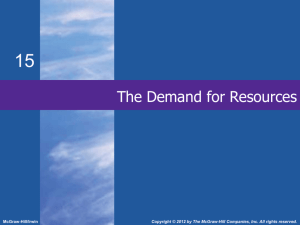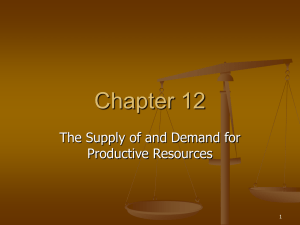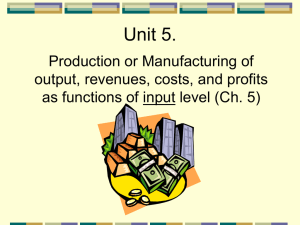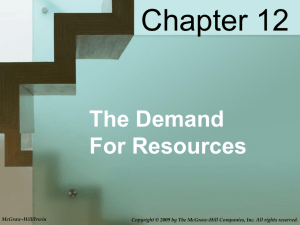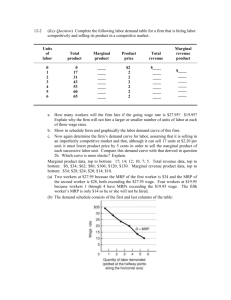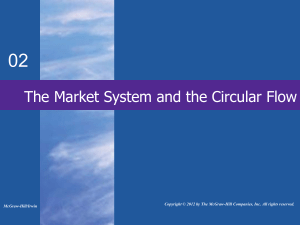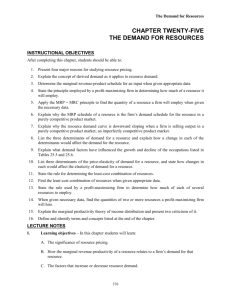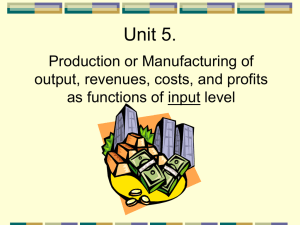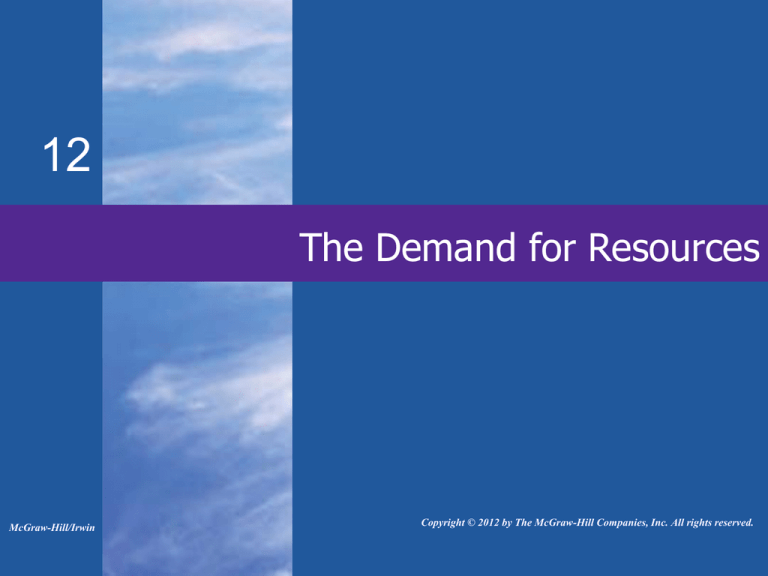
12
The Demand for Resources
McGraw-Hill/Irwin
Copyright © 2012 by The McGraw-Hill Companies, Inc. All rights reserved.
Resource Pricing
• Firms demand resources
• Focus on labor
• Resource prices are important
• Money-income determination
• Cost minimization
• Resource allocation
• Policy issues
LO1
12-2
Resource Demand
• All markets are competitive
(good and resource)
• Derived demand depends on:
• Productivity of resource (MP)
• Price of the good it helps produce (P)
• Marginal revenue product (MRP)
• Change in TR resulting from unit
change in resource (labor)
LO1
12-3
Resource Demand
•Rule for employing resources:
• MRP = MRC
• Marginal Revenue Product (MRP)
Marginal
Revenue
Product
=
Change in Total Revenue
Unit Change in Resource Quantity
• Marginal Resource Cost (MRC)
Marginal
Resource
Cost
LO1
=
Change in Total (Resource) Cost
Unit Change in Resource Quantity
12-4
MRP as Resource Demand
(1)
(2)
Units of Total Product
Resource
(Output)
0
1
2
3
4
5
6
7
(3)
Marginal
Product (MP)
(4)
Product
Price
7
6
5
4
3
2
1
$2
2
2
2
2
2
2
2
0]
7]
13 ]
18 ]
22 ]
25 ]
27
]
28
(5)
Total Revenue,
(2) X (4)
$0
14
26
36
44
50
54
56
]
]
]
]
]
]
]
(6)
Marginal Revenue
Product (MRP)
$14
12
10
8
6
4
2
$18
Purely
Competitive
Firm’s
Demand for
A Resource
Resource Wage
(Wage Rate)
16
14
12
10
8
6
4
D=MRP
2
0
-2
1
2
3
4
5
6
7
Quantity of Resource Demanded
LO1
12-5
MRP as Resource Demand
(1)
(2)
Units of Total Product
Resource
(Output)
0
1
2
3
4
5
6
7
(3)
Marginal
Product (MP)
0]
7]
13 ]
18 ]
22 ]
25 ]
27
]
28
(4)
Product
Price
(5)
Total Revenue,
(2) X (4)
$2.80
2.60
2.40
2.20
2.00
1.87
1.75
1.65
7
6
5
4
3
2
1
$ 0.00
18.20
31.20
39.60
44.00
46.25
47.25
46.20
]
]
]
]
]
]
]
(6)
Marginal Revenue
Product (MRP)
$18.20
13.00
8.40
4.40
2.25
1.00
-1.05
$18
Imperfectly
Competitive
Firm’s
Demand for
A Resource
Resource Wage
(Wage Rate)
16
14
D=MRP
(Pure Competition)
12
10
8
6
4
2
0
D=MRP
(Imperfect
Competition)
1
2
3
4
5
6
7
-2
Quantity of Resource Demanded
LO1
12-6
Determinants of Resource Demand
• Changes in product demand
• Changes in productivity
• Quantities of other resources
• Technological advance
• Quality of the variable resource
LO2
12-7
Determinants of Resource Demand
• Changes in the price of substitute
•
LO2
resources
• Substitution effect
• Output effect
• Net effect
Changes in the price of complementary
resources
12-8
Determinants of Resource Demand
LO2
12-9
Occupational Employment Trends
• Rising employment
• Services
• Health care
• Computers
• Declining employment
• Labor saving technological change
• Textiles
LO2
12-10
Employment Trends
10 Fastest-Growing U.S. Occupations in Percentage Terms, 2008-2018
Occupation
Employment, Thousands of Jobs Percentage
2008
2018
Increase*
Biomedical engineers
16
28
72.0
Network Systems and data
communications analysts
292
448
53.4
Home health aides
922
1383
50.0
Personal and home care aides
817
1193
46.0
Financial examiners
27
38
41.2
Medical scientists, except
epidemiologists
109
154
40.4
Physicians assistants
75
104
39.0
Skin care specialists
39
54
37.9
Biochemists and biophysicists
23
32
37.4
Athletic trainers
16
22
37.0
Source: Bureau of Labor Statistics, http://www.bls.gov
LO2
12-11
Employment Trends
10 Most Rapidly Declining U.S. Occupations in Percentage Terms, 2008-2018
Occupation
Textile machine workers
35
21
-40.7
Sewing machine operators
212
141
-33.7
Postal service workers
180
125
-30.3
56
41
-26.7
246
182
-26.1
51
39
-24.3
File clerks
212
163
-23.4
Machine feeders and
offbearers
141
110
-22.2
Paper goods machine setters
operators, tenders
103
81
-21.5
Computer operators
110
90
-18.6
Lathe operators
Order clerks
Photographic processing
machine operators
LO2
Employment, Thousands of Jobs Percentage
2008
2018
Increase*
12-12
Elasticity of Resource Demand
Erd =
Percentage Change in Resource Quantity
Percentage Change in Resource Price
• Ease of resource substitutability
• Elasticity of product demand
• Ratio of resource cost to total cost
LO2
12-13
Optimal Combination of Resources
• All resource inputs are variable
• Choose the optimal combination
• Minimize cost of producing a given
output
• Maximize profit
LO3
12-14
The Least Cost Rule
• Minimize cost of producing a given
•
output
Last dollar spent on each resource
yields the same marginal product
Marginal Product
Of Labor (MPL)
Price of Labor (PL)
LO3
=
Marginal Product
Of Capital (MPC)
Price of Capital (PC)
12-15
Profit Maximizing Rule
• MRP of each resource equals its
price
PL = MRPL and PC = MRPC
MRPL
PL
LO3
=
MRPC
PC
=1
12-16
Income Distribution
• Paid according to value of service
• Workers
• Resource owners
• Inequality
• Productive resources unequally
•
LO3
distributed
Market imperfections
12-17
Income Distribution
• Numerical Illustration
• Data for finding the least-cost and
profit-maximizing combination of
labor and capital
12-18
Input Substitution: The Case of ATMs
• Banks use ATMs instead of people
• Least-cost combination of resources
• ATMs debuted about 35 years ago
• 11 billion U.S. transactions per year
• 80,000 tellers eliminated 1990-2000
• Former tellers find new jobs
• Customer convenience
LO3
12-19

